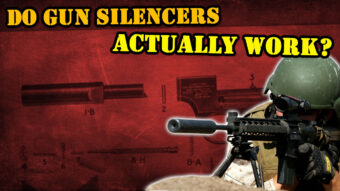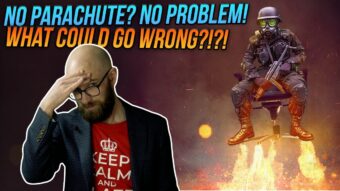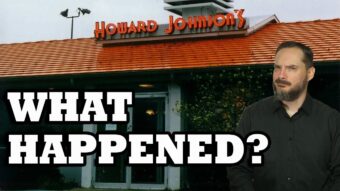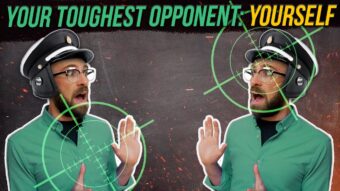
The noise produced by a firearm varies widely depending on type and ammunition, ranging from around 140 decibels for a .22 calibre rimfire rifle to 172 decibels for a .50 calibre machine gun. The U.S. Occupational Health and Safety Authority or OSHA defines 140 decibels as the threshold for pain and immediate hearing loss and 85 decibels as the threshold for hearing loss after prolonged exposure, meaning that using any firearm for an extended period without ear protection will result in permanent hearing loss. The sound of a gunshot comes from three different sources, the first being the movement of components within the firearm’s mechanism or action such as the hammer, firing pin, bolt, or slide. The second source of noise is the bullet breaking the sound barrier as it exits the barrel, creating a tiny sonic boom. This is also the source of a bullwhip’s distinctive crack. But the most significant source of noise is the sudden expansion of hot propellant gas as it exits the barrel behind the bullet, and it is this effect which suppressors seek to mitigate.
The first modern firearm suppressor was invented in 1902 by Hiram Percy Maxim, son of Sir Hiram Stevens Maxim, inventor of the first practical machine gun. Maxim, an avid hunter and target shooter, sought a means of indulging in his hobby without bothering his neighbours with the noise. In 1908 he formed the Maxim Silent Firearms Company to produce suppressors for both military and civilian clients. The company flourished until 1934, when the National Firearms Act or NFA banned the private sale of suppressors in the United States. The Maxim suppressor was a relatively simple device, consisting of a short tube fitted to the muzzle of a firearm containing a set of regularly-spaced spiral metal baffles. Each baffle in turn featured a central hole, forming a cylindrical channel down which the bullet could travel. According to a later Maxim Company brochure, the device worked as follows:
“[The propellant gasses] are made to whirl around inside the Silencer. This whirling forces the gas to fly out from the center by centrifugal force leaving a central space, just the same as when water is whirled around in a set bowl, a hole or space forms at the center. This leaves the space for the bullet to make its passage. The gas cannot pass through this space, until it slows down. This causes it to discharge into the atmosphere gradually. This absolutely prevents noise and also reduces recoil over two-thirds.”
Modern suppressors work more or less on the same principle, though nearly all have abandoned Maxim’s spiral baffles for straight ones as the former are more expensive to manufacture and prone to overheating. By slowing down and cooling the propellant gases and allowing them to dissipate over a longer period of time, suppressors mitigate the sudden expansion responsible for much of a gunshot’s noise. Many suppressors also incorporate a hollow expansion chamber at the rear, which allows the propellant gases to expand and decelerate before reaching the baffles, increasing their effectiveness. Efficiency can be further enhanced by filling the suppressor with water or grease, which serves to quickly cool down and reduce the pressure of the propellant gases. However, this liquid quickly evaporates and must be topped up after a certain number of shots. A similar technique is to pack the expansion chamber with metal mesh or other porous, conductive material. Like the water or grease, this acts as a heat sink to cool down the propellant gases, but lasts significantly longer and requires less maintenance.
While most suppressors use Maxim-style metal baffles, a few models use rubber versions known as wipes without pre-cut central holes. Instead, the bullet must punch though the wipes, which then seal up behind it, trapping the propellant gases in the suppressor. Wipes also serve the secondary function of slowing down the bullet, for reasons we will soon cover. This system can make a suppressor extremely efficient, but its effectiveness degrades significantly after only a handful of shots as the wipes become increasingly worn out, requiring the wipes to be frequently replaced. For this reason, wipe-based suppressors are largely relegated to firearms intended for infrequent use, such as by special forces or pilots shot down behind enemy lines.
Yet another principle employed by certain suppressors is destructive interference or noise cancellation. This involves the use of a hollow chamber at the end of the suppressor, precisely sized so that any residual sound waves exiting the baffles are reflected back and cancel themselves out. This is the same mechanism used by ordinary automotive mufflers; indeed, Hiram Percy Maxim invented the muffler concurrently with the silencer, with mufflers becoming the Maxim Company’s main source of revenue after suppressors were banned in 1934. Newer, more advanced silencers make use of a technique called frequency shifting whereby propellant gases are vented through specially-sized holes to shift the frequency of the noise beyond the range of human hearing – similar in principle to a dog whistle.
But while advanced suppressors can eliminate much of the noise generated by the expansion of propellant gases, as previously mentioned this is not the only source of noise in a firearm. Thus, a firearm fitted with the world’s best suppressor will still generate significant noise in the form of the bullet’s sonic boom and the cycling of the action. The latter problem is more easily managed in manually-operated firearms like bolt-action rifles, as the shooter can wait until they have retreated out of enemy earshot before cycling the action. The de Lisle [“Duh -Leel”] Carbine used by British Commandos during WWII even featured rubber pads to muffle the sound of the bolt being opened and closed. Mechanical noise is harder to avoid in self-loading firearms, so in many cases such weapons are operated in single-shot mode only. For example, the Knight’s Armaments XM9 – a suppressed M9 Beretta pistol issued to U.S. Air Force crews for self-defence behind enemy lines – features a special lever to lock the slide closed, preventing it from cycling and producing noise when fired. This means the pistol must be manually re-cocked after each shot, but given the dire circumstances under which the weapon is meant to be used, this is considered an acceptable trade-off.
The sonic boom produced by the bullet is comparatively easier to deal with. While certain cartridges like .45 ACP are naturally subsonic, most ammunition must be slowed down for use in suppressed firearms. This is accomplished in a variety of ways, the simplest being simply to reduce the propellant powder load in the cartridge itself. Another technique, as previously mentioned, is to fit the suppressor with solid rubber wipes. The friction generated by punching through these wipes slows down the bullet, such that by the time it emerges from the suppressor it is travelling at subsonic speeds. However, in addition to quickly wearing out, wipes also significantly degrade the accuracy of the bullet, meaning wipe-based suppressors are no longer widely used. A third way of slowing down the bullet is to drill holes in the barrel to bleed off propellant gas, preventing the bullet from attaining supersonic velocity. This method has the advantage of allowing the use of regular supersonic ammunition without the loss of accuracy associated with wipe-based suppressors. However, all three of these techniques are only applicable to pistol-calibre cartridges like 9mm Parabellum; larger rifle cartridges are too powerful to be effectively slowed down by wipes or gas venting, and become unstable and inaccurate at subsonic speeds. Thus, no matter how sophisticated a suppressor they are fitted with, most rifles will produce an unavoidably loud supersonic crack.
Suppressors can either be detachable – screwing or latching onto the end of the barrel – or integral to the firearm itself. For an integral suppressor to work, part of the barrel barrel must be ported or drilled with holes to allow propellant gas to vent out; otherwise the gas would bypass the suppressor entirely, rendering the whole device pointless. Integrally-suppressed firearms tend to be quieter than those with detachable suppressors due to the greater care taken in integrating the firearm’s ballistics with the suppressor design. However, a well-designed detachable suppressor can be just as effective, and examples have been produced for nearly every type of firearm, even shotguns – so yes, that scene from No Country For Old Men where Mexican hitman Anton Chigurh uses a suppressed shotgun is technically accurate. But while silencers have been developed for machine guns and submachine guns, they are of relatively limited usefulness in this role. This is because the rapid rate of fire does not give the propellant gas sufficient time to vent from the suppressor, causing a buildup of pressure that severely reduces sound suppression. Sustained automatic fire can also overheat and damage the baffles, quickly destroying the suppressor. For this reason, suppressed machine guns are typically fired in semi-automatic mode only – or, at worst, in short bursts.
One type of firearm that cannot be easily suppressed – despite Hollywood’s frequent claims to the contrary – is the revolver. This is because the vast majority of revolvers feature a large gap between the front of the cylinder and the rear of the barrel. Much of the sound produced by a revolver comes from propellant gas leaking through this cylinder gap, which a suppressor cannot mitigate. There is, however, one major exception to this rule. The Russian M1895 Nagant revolver features a mechanism that pushes the cylinder forward against the rear of the barrel just before the hammer drops, and fires and unusual 7.62x38mm cartridge whose bullet is seated deep in the brass case. This allows a tight seal to form between the cylinder and barrel, preventing gas from leaking out and allowing the Nagant to be suppressed. Indeed, for several decades suppressed Nagant revolvers were used by the Soviet NKVD secret police and later Vietnamese Viet Cong guerrillas to carry out covert assassinations.
“But Simon,” you are probably thinking right now, “All of this is very interesting, but do silencers actually make firearms silent?” Alas, once again Hollywood has been lying to you, for in real life no suppressor is capable of completely silencing the sound of a gunshot. For example, the even best commercial suppressors can only reduce the noise of a .22 calibre rifle from 140 to 111 decibels, a 9mm handgun from 162 to 126 decibels, and a .556 calibre AR-15 rifle from 165 to 132 decibels. This, as you may have noticed, is still extremely loud – a far cry from the barely audible thump or hiss commonly depicted in films and TV shows. Of what use, then, are suppressors? While suppressors can’t fully silence firearms, they can still significantly reduce their noise profile, making gunshots less recognizable as such and harder to locate by enemy forces. But trapping, cooling, and diffusing the propellant gases as they emerge from the barrel, suppressors can also eliminate muzzle flash and reduce felt recoil by up to 30%, making a firearm even stealthier and easy to handle. Finally, in a civilian context, suppressors can allow firearms to be used in enclosed spaces without deafening the user or bystanders, reduce or eliminate the need to wear hearing protection while shooting, and limit the distance over which gunshots can be heard. Indeed, in many European countries including the UK and Finland, civilian hunters and target shooters are encouraged to use suppressors in order to reduce noise pollution. Strangely, mainstream acceptance of suppressors has not carried over across the Pond, despite the significantly laxer gun laws in North America compared to Europe. This is largely due to the popular perception of suppressors as a tool of assassins, criminals, and other nefarious characters, a perception reinforced by countless books, films, and TV shows. Suppressors are prohibited outright in 9 U.S. states and in Canada, and obtainable everywhere else only via a complicated and expensive application process through the Bureau of Alcohol, Tobacco, and Firearms. Since 2011, the National Rifle Association and the National Suppressor Association have run concerted campaigns aimed at debunking common myths regarding suppressors and promoting their use for reducing noise pollution around outdoor ranges and hearing loss among sport shooters and bystanders. So far, however, these campaigns have done little to change the ATF’s stance on the issue.
While the best modern suppressors are only capable of lowering the sound of a gunshot to just below the 140 decibel threshold for immediate hearing loss, a handful of historical firearms have come very close to attaining “Hollywood Quiet” levels of suppression. The most famous example is the previously-mentioned de Lisle carbine, an integrally-suppressed .45 calibre bolt-action rifle used by British Commandos during the Second World War. In official testing, the sound of a de Lisle firing registered at 85.5 decibels, while the Welrod – an integrally-suppressed .32 calibre pistol developed for British Special Operations Executive or SOE, registered as low as 73 decibels. However, 1940s sound-measuring equipment was not as sophisticated as today, and modern testing has pegged these numbers at closer to 110 and 122 decibels, respectively. Similarly, the suppressed version of the Sten submachine gun also used by British Commandos registers at around 127 decibels. While these noise levels are, according to OSHA, equivalent to a loud nightclub or a construction site, in practice these weapons were almost unrecognizable at even close ranges. For example, another ultra-quiet firearm of the period was the HiStandard HDM, a .22 calibre integrally-suppressed pistol developed for the Office of Strategic Services or OSS – the precursor to the CIA. The effectiveness of this weapon was dramatically demonstrated by OSS head William Donovan during a meeting with U.S. President Franklin Roosevelt at the White House. While Roosevelt was busy dictating a letter, Donovan turned his back and emptied an HDM pistol into a sandbag. He then turned around and announced to the astonished President that he was finished with his demonstration. Despite the pistol registering at 120 decibels, Roosevelt reportedly hadn’t realized that a firearm was being discharged.
The quietest firearms on record, however, are the MSP, SP-4M, OTs-38, and PSS pistols developed by the Soviet Union and later the Russian Federation for use by KGB and FSB operatives. Instead of being suppressed themselves, these weapons are designed to use special integrally silenced ammunition – specifically the 7.62x42mm SP-4 cartridge. This cartridge features a sliding piston ahead of the propellant powder charge, which upon firing is propelled forward and strikes the base of the bullet, pushing it down the barrel. The piston then stops and seals off the end of the cartridge, preventing propellant gas from escaping and completely eliminating noise, muzzle flash, and smoke. In official testing, these pistols registered at only 110 decibels, with nearly all this noise coming from the firing mechanism. This stealth, however, comes at the cost of muzzle velocity, with the Russian silenced pistols having an effective range of only 25 metres. A similar weapon called the Quiet Special Purpose revolver of QSPR was developed by the U.S. Army for use in Viet Cong tunnels during the Vietnam War, while the captive-piston suppression concept has even been applied to artillery in the form of the Belgian Fly-K spigot mortar. Unlike in conventional mortars, where the bomb is dropped down and fired from a tubular barrel, the Fly-K bomb features a hollow tail boom containing a propellant charge and captive piston, which slides over a cylindrical launch rod or spigot. As in the SP-4 cartridge, upon firing the piston is propelled down the length of the tail boom, launching the bomb off the spigot. It then halts at the end of its travel, sealing off the boom and eliminating all noise and flash.
Yet despite their numerous advantages, outside of special operations applications suppressors have not been widely adopted by regular military forces. At first glance this might seem strange, for what army wouldn’t want its troops to be stealthier? However, there is a sound psychological reason for militaries eschewing suppressors: the doctrine of suppressing fire. On the battlefield, small arms fire is often used not to directly engage the enemy, but rather to keep their heads down so friendly forces can safely advance. In these situations, the louder the gunshot, the better; suppressed firearms simply do not possess the same intimidation factor.
In conclusion, suppressors are not the magical, über-sneaky devices Hollywood would have us believe, capable of muffling gunshots to the level of a whisper. Nonetheless, they do have a wide range of applications, from disguising the nature and origin of gunshots to reducing hearing loss and noise pollution. Thus, in spite of their less than savoury reputation, suppressors remain a useful part of any civilian or military shooter’s toolkit. And before you ask: no, neither an empty pop bottle or a pillow will work as an effective improvised suppressor; that, too, is pure Hollywood. And if you are caught trying to improvise a suppressor without a permit, you will likely find yourself being told you have the right to remain silent.
If you liked this article, you might also enjoy our new popular podcast, The BrainFood Show (iTunes, Spotify, Google Play Music, Feed), as well as:
- How Dangerous are Rubber Bullets and Stun Guns?
- Gun “Silencers” Don’t Make Them Anywhere Near Silent
- Is There a Proper Way to Fire Two Guns at Once?
- Why Do They Use 21 Guns in the 21 Gun Salute?
Maddox, Brandon, How Loud is a Gunshot? Gun DB Levels Compared, Silencer Central, September 11, 2019, https://ift.tt/pIcMwH1
Holmes, Jonathan, How Loud is a 50 BMG in Decibels? Cement Answers, https://cementanswers.com/how-loud-is-a-50-bmg-in-decibels/
Maxim Silencer Company Photographs, Archival Collections at Hagley Museum & Library, 2015, https://findingaids.hagley.org/repositories/2/resources/772
Dear, Ian, Sabotage and Subversion: The SOE and OSS at War, Cassell Military Paperbacks, 1996
Devaney, Tim, Gun Lobby Seeks to Calm Fears About Silencers, The Hill, May 29, 2017, https://thehill.com/business-a-lobbying/335348-gun-lobby-seeks-to-calm-fears-about-silencers
The Rimfire Report: The Clandestine High Standard HDM, The Firearm Blog, June 1, 2020, https://www.thefirearmblog.com/blog/2020/06/01/high-standard-hdm/
Silenced Sten Guns, Forgotten Weapons, Reddit, https://www.reddit.com/r/ForgottenWeapons/comments/c6k8o1/silenced_sten_guns/
Suciu, Peter, Meet the Russian Nagant Gun – the First Silenced Revolver, National Interest, June 29, 2020, https://nationalinterest.org/blog/buzz/meet-russian-nagant-gun—-first-silenced-revolver-163734
Occupational Noise Exposure, United States Department of Labor, https://www.osha.gov/noise
Rome, Robert, WWII Silent Killer Still Lives, Gung-Ho, June 1984, http://www.valkyriearms.com/images/delisle.pdf
OTs-38 Silent/Sound Suppressed Revolver (Russia), Modern Firearms, https://ift.tt/frDLpBM
The post How Do Silencers Work, and How Silent Do They Actually Make Guns? appeared first on Today I Found Out.



0 comments:
Post a Comment
Please ,
Don't enter span link